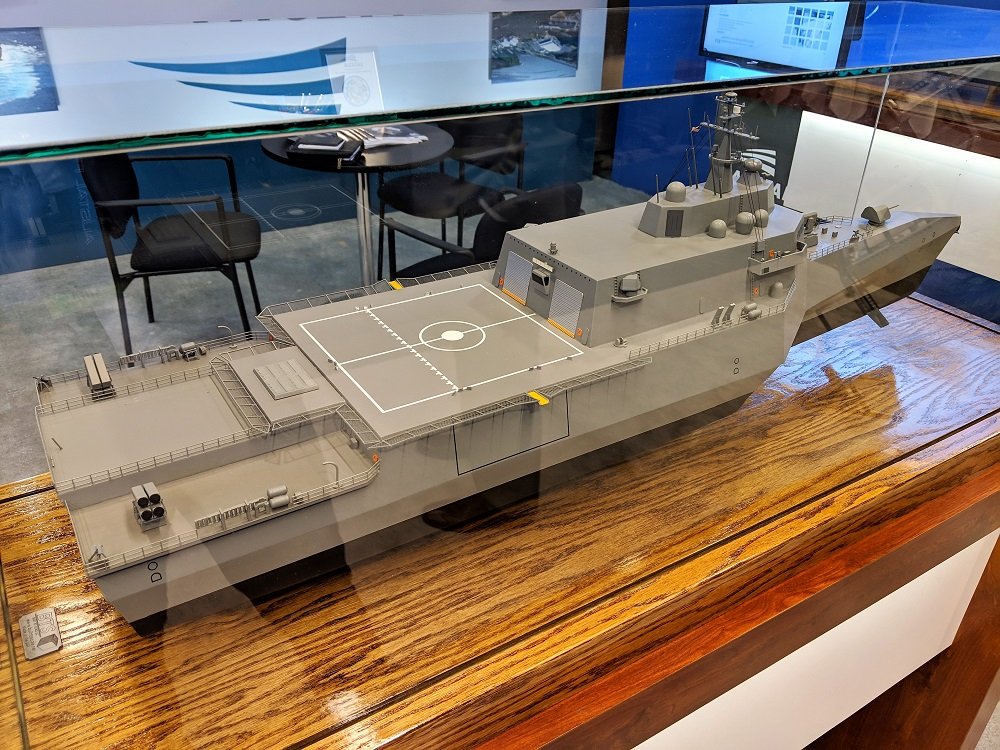Acadia class Multi-Role Command Cruiser
Operators
- Royal Canadian Navy (2018-present) [5]
- Royal Navy (2018-present) [5]
- Royal Australian Navy (2019-present) [2]
- Indian Navy (2021-present) [4]
- South African Navy (2022-present) [1]
Number Built
17 (5 Royal Canadian Navy, 5 Royal Navy, 4 Indian Navy, 2 Royal Australian Navy, 1 South African Navy)
Builders
- Newfoundland Shipyards, Bonavista, Newfoundland and Labrador, Canada (1x Royal Canadian Navy)
- Canadian Shipbuilding Corporation New Brunswick Shipyards, Shediac, New Brunswick, Canada (1x Royal Canadian Navy, 1x Indian Navy)
- Canadian Shipbuilding Corporation Cape Breton Shipyards, Edwardsville, Nova Scotia, Canada (1x Royal Canadian Navy, 1x South African Navy)
- Versatile Pacific Shipyards, Vancouver, British Columbia, Canada (2x Royal Canadian Navy)
- Harland and Wolff Shipbuilders, Belfast, Northern Ireland, United Kingdom (2x Royal Navy)
- Cammell Laird, Birkenhead, Merseyside, United Kingdom (1x Royal Navy)
- Swan Hunter, Wallsend, Tyne and Wear, United Kingdom (2x Royal Navy)
- Australian Shipbuilding Corporation Eastern Yard, Williamstown, Victoria, Australia (2x Royal Australian Navy)
- Mumbai Naval Dockyards, Mumbai, Maharashtra, India (1x Indian Navy)
- Cochin Shipyards, Kochi, Kerala, India (2x Indian Navy)
Displacement
24,670 tons (full load)
Length
829 ft 8 in (252.88 m)
Beam
92 ft 2 in (28.09 m)
Draft
28 ft 7 in (8.72 m)
Complement
886 (90 officers, 112 senior ratings, 684 men)
Propulsion
- 2 AECL HTNR-01 high-temperature gas-cooled prismatic-block-design nuclear reactors
- 4 L&T Nuclear NES-11 nuclear heat exchangers
- 4 Vektris Engineering MS7A geared steam turbines
- 2 General Motors EMD 24-265J2 auxillary diesel power generators
- 4 Western Electric Model 35NS induction electric motors
- 4 Rolls-Royce Kamewa M4550 waterjets
- Research in Motion ISPP-4A integrated power and propulsion system
Power Output
152.32 MW (204,170 shp) maximum power output, maximum available for propulsion 160,000 shp
Top Speed
35.2 knots (40.5 mph, 65.2 km/h)
Range
Theoretically unlimited, original nuclear fuel core lasts 30 months
Endurance
75 days
Armament
- 2 Mk.184AC Poseidon 16-cell vertical launch systems (32 RGM-186A Algoolik anti-ship missiles)
- 2 Sylver 2A80C Nujalik 64-cell vertical launch systems (128 missiles)
- 1 Sylver 2A70C Tornat 64-cell vertical launch system (64 missiles)
- 4 Sea Ceptor V2A 16-cell vertical launch systems (64 CAMM anti-aircraft missiles)
- 1 VL-ASM2 Makara 16-cell vertical launch system (16 RUM-188A Varuna anti-submarine missiles)
- 4 Mk.64F5 155mm/62-caliber naval guns (two two-gun mounts, 650 rounds per gun)
- 8 Mk.95F2 76mm/62-caliber naval guns (four two-gun mounts, 2200 rounds per gun)
- 8 M2 Browning 12.7mm machine guns (4 twin mounts, 2000 rounds per gun)
- 2 Mark 32 SVTT 12.75" triple torpedo tube sets
Radars and Sensor Systems
- DRDO CANTIS Mark 21AV automatic naval tactical data system, containing:
-- Pacific Alliance PS32 liquid-cooled supercomputer
- Commonwealth Air Defense Systems SV-2A Ataksak Anti-Air Missile System, consisting of:
-- 1 Thales Nederland/Research in Motion APAR-3A 3D active phased array radar
-- 1 Thales Nederland/Research in Motion S1850M long-range air-search radar
-- 1 Raytheon AN/SPS-67(V)11 medium-range surface-search radar
-- 2 Thales Nederland/Vektor Electrotechnic Sirius IRST infrared search and track systems
-- 2 Dalsa Technologies Northlight 2A1 electro-optical surveillance and tracking systems
-- 5 Commodore Defense ADV04 continuous-wave fire control radars
-- 2 Raytheon/Vektor Electrotechnic SPQ-9B gunfire control radars
- 2 Rheinmetall Pathfinder Mark II navigation radars
- 1 DRDO CANTIS Mark 22UW anti-submarine warfare system (Type 2084A variable-depth hull sonar, 1 C1633A4 towed sonar array, 1 C1634A1 area sonar system)
- 1 Ultra Electronics S2170 SSTD torpedo defense system
- 1 Raytheon/Vektor Electrotechnic AN/SLQ-32(V)8 electronic warfare system
Aircraft Carried
3 Canadair VS-145C Poseidon anti-submarine tiltwings
12 Dragonflyer X6A maritime amphibious UAV
Boats Carried
4 SB90N Fast Combat Boats
As others say a bit of context such as the POD and some very brief TL details could help. It seems an interesting design however, although the number of VLS appears rather large.
At risk of getting into current politics, good luck getting the British Government to fund 5 nuclear powered battlecruisers (or even 5 patrol boats) as well.
Ignorant question: does Canada have the dock to build a ship that big?
When you are talking about building nuclear battlecruisers then building docks for them is a relatively minor point.
Perhaps before we get a bit too critical of the member, let us at least give them a chance to explain the POD and TL changes because that should provide context. 😉
I'd assume that to get these built you'd need a vastly different Commonwealth etc.
Indeed, which is why this isn't completely impossible. In present context, yes, but with a POD far enough back or impactful enough to cause significant changes then given the AH there could be ways it may be possible.
Sargon
Last edited:








